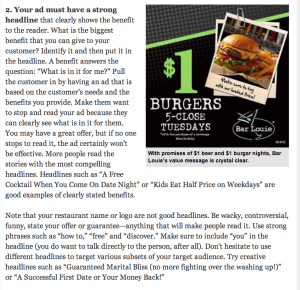My Bold Assertion #3: Everything you do “builds your image” in some way. The question is whether you’re conscious of it, and whether you’re in control of it.
My Bold Assertion #2: If you can’t articulate the image you want to build, you’ll probably build something typical. And typical, while not necessarily terrible, translates to “boring, easy to not notice, and bound to be forgotten quickly.” If you perform more than one marketing act, your efforts will probably lack consistency—not only failing to create any kind of momentum or efficiency, but confirming to anybody who notices that you don’t really know who you are.
My Bold Assertion #1: Nobody knows how to sell eating. Everything that’s ever worked before happened yesterday, and nothing has happened tomorrow yet.
All of which I mention because I just read an article full of how-to’s, all offered helpfully and (I’m sure) in good faith to people who really need and want help. A lot of the ideas are probably decently effective.
It’s worth a read.
I do not know this Amy Foxwell, the author. Her bio makes her sound like an expert.
Here she is, after having fallen in love with a chef:
So. Well, here goes.
Amy makes a couple of assertions I’d like to, like, y’know, if not outright challenge (I’m a polite guy, and maybe I’m a little chicken) then at least—okay, I need a word. “Address.” Amy makes assertions I’d like to address.
Amy declares that “image building” advertising is for the folks at Yum! Brands and Darden Restaurants to fuss over. And I can’t agree with that, because the fact is, everything you allow your logo on either builds or starts to unbuild your image.
At this point, if Amy were here (I really want Amy to be an ally, and a friend of the blog, and all that, so I don’t want to irritate her past the potential for reconciliation having never even met her), I can easily image from that YouTube video that she would pause, purse her lips, draw in a short little breath that indicated she was about to come at me with both guns blazing, and then say something like, “Okay, um, Charlie—it’s Charlie, right?—I guess you’re really focusing in on a minor linguistic issue when I’m trying to give people with no money and no time and their entire life savings on the line some useful tools, and to be honest, an image campaign without a clear call-to-action and a plainly stated benefit will never pay off for them.”
Did I get close to what you might say? I’m seriously trying to not be snarky or unpleasant.
But that was my other point about the article. I agree with the theory of what Amy says about benefit-driven messages. But then she gives this as an example:

Much of what Amy Foxwell says here, I agree with. In theory. Much of it, especially the examples she gives, seem to me to contradict her theory—and then I glance over at the Bar Louie ad and I am truly moved to tears: that ad looks like everything every lookalike restaurant was ever sold by every pushy rep from every trashy little ad pub ever run off a printing press. If I have ANY opinion of Bar Louie after seeing this, it’s that Bar Louie is indistinguishable from Bar Sam, Bar Ricky, Bar Maxwell and Bar Eddy. Especially Bar Eddy. I think Louie and Eddy are brothers.
And I think that is a perfect example of an ad that makes that restaurant look like every restaurant that ever existed and was not special in any way. Amy does suggest “getting creative” and pointing out that you don’t have to wash the dishes, which helps a couple get along—and that is a benefit.
But the fundamental question of “Who are you?” lingers.
What makes your small or mid-size restaurant different from the small or mid-sized restaurant a two-minute drive away? People will use every cue you give them to answer that—and if you run advertising or collateral or speak in the media in a way that fails to make it clear what you went into business for, then you’re just going to blend in.
You’re going to have no image.
And you’re never going to be multi-neighborhood, or multi-municipality, much less multi-national, if you lost control of who you are.
